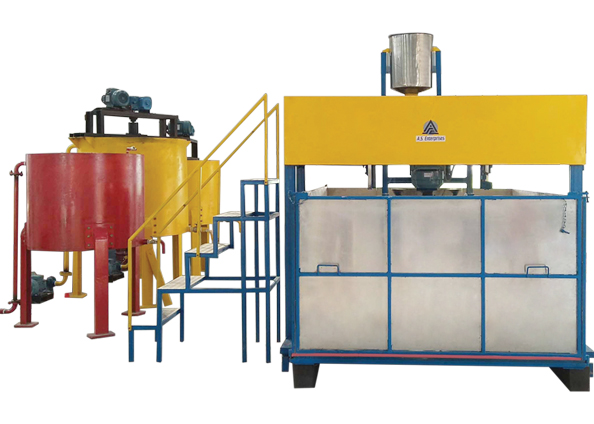Foam Making Machinery ( Best Foam Machinery in India)
To produce foam blocks using three well-known processes, a complete plant of best foam machinery is required. The most recent manufacturing methods are the Max constant foam process, batch foaming, and recovered foam plant. Machine advancements improve the overall quality of foam. Toluene-di-isocynate, Polyol, methylene chloride, stannous octane, amine, and silicon are charged into the machinery, resulting in the most advanced chemical reaction. The imported chemical pump delivers all of these chemicals to the mixing head.
Procedure:
- In preparation for the process, all chemicals are weighed and stored.
- The polyol and catalysts are poured into the mixing vessel, and the first mixing begins by pressing the speed 1 push button.
- Now, TDI and water are poured in quick succession, and speed 2 is turned on.
- Before releasing the chemicals into the mould, the machine stirs them.
- The mould’s open door is manually closed.
- The block can be demoulded after 5 to 10 minutes.
General Specifications of the foaming machine:
A 10 HP mixer motor with an AC drive for speed control, a 210-litre mixing tank, and a 125-KG mixing capacity are included in the foaming equipment. It requires 10 horsepower and runs on a 415V AC 50Hz power supply. It necessitates a 4m x 8m area. Its control panel consists of a single 6-by-6-foot mould with aluminium sheets on the sides and a wooden board on the bottom. Material is discharged from the bottom by a manually operated lifting mechanism.
Special Features:
- Mixing SS tank
- AC drive with 10 horsepower for variable mixing speed
- The release of chemicals in the mould occurs automatically after mixing.
- Digital timing is integrated for both the preliminary and final mixing processes.
- Its operation is straightforward.
- An aluminium layer on the mould’s side walls to provide a smooth finish.
The Benefits of Buying a Foam Machinery
Since the cost of acquiring a new cutting machine is high, retrofitting out-of-date and faulty machines is highly profitable because the costs for a second lifetime of a cutting machine are only a fraction of the prime costs for a new machine. This is especially true for CNC-contour cutting machines, which have extremely high starting costs.
The reduction in maintenance costs must also be mentioned because the machine becomes more reliable.
Downtimes and potential production stops are avoided as a result of a more reliable machine, and costs are further reduced. There will be no more long waits due to machine component repairs. All of this contributes to the cutting machine’s increased productivity.
Another advantage is increased computing power, which results in faster processing cycles. The improved ease of use reduces incorrect inputs at the machine’s control panel as well as training times for personnel.
The mechanical overhaul of the machine also benefits the cutting tools because they now have a longer life and thus not only improve the quality of the cut product but also help reduce total operating costs.
Conclusion:
It provides numerous benefits for the cutting machines described, such as significant cost savings. They result from the machine’s second lifetime because the costs for the best foam machinery in india are a fraction of the costs for acquiring a new machine.
Additional benefits stem from the overall quality improvement. The machine-related optimizations that result in an easier and more reliable operation of the machine must be mentioned first.

